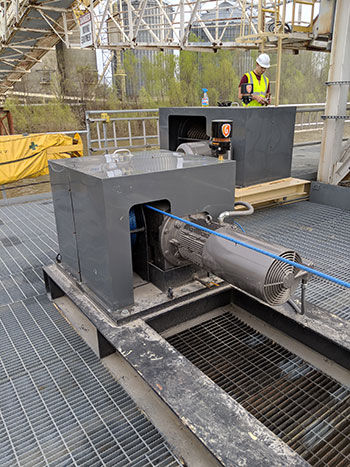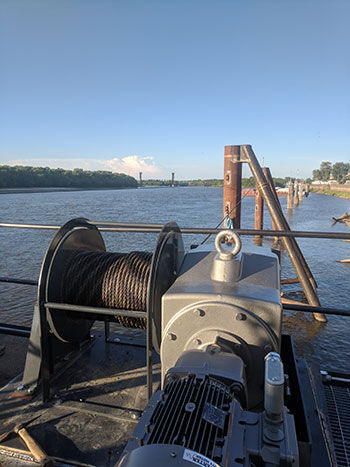Despite this proud history — or perhaps because of it — SLM has begun to transform itself over recent years. After the retirement of several key employees, the company began looking for ways to combine their unique experience in mechanical lifting devices with modern drive technology. This includes state-of-the-art control systems, hydraulically actuated leveling equipment, and automated solutions that make SLM products more cost-effective, reliable, and above all, safer.
“That’s where our relationship with NORD started,” said Kenneth Behrman, SLM’s engineering and external affairs manager. “In order to accomplish our goals, we had to find the very best drive technology available and the application support necessary to integrate it with our winches and hoists. We soon found that NORD has both, with a broad product selection and excellent availability, as well as the price points we needed to be competitive.”
One of the first examples of this collaboration was on a funicular hoist used to transport personnel to and from a hydroelectric dam located in the southeastern United States. SLM built the original system in 1912, and while it was still functional, the customer was asking that it be upgraded to modern operational standards. One of the challenges, however, was that the facility is protected by historic preservation laws, so the replacement equipment had to be minimally invasive.
“To design a hoist that would fit into the original space but meet today’s much higher safety factors, SLM worked with NORD to design a CLINCHER gearbox paired with an open gearing set,” says Behrman. “CLINCHERs are typically used for agitators and mixers or conveyors, but the unit they recommended possessed the required characteristics for in-line operation with an open gearing set as well as the capacity to transmit the required power generation, all in a small footprint.”
SLM synthetic rope barge breasting winch with NORD gearmotor at an inland grain elevator.
In another example, SLM addressed the need for more efficient and standardized barge positioning systems. Behrman notes that legacy positioners are often unique to each loading facility, based on decades-old technology that requires a high level of experience to operate. Given the current labor shortage and the fact that many dock workers are approaching retirement age, these skills are increasingly hard to find.
What’s more, much of this work is manual — personnel must hoist heavy lines and walk along the sides of barges and docks, even in inclement weather. “It’s a difficult and unsafe job,” he said. “Because of this, it’s tough to find people today that are willing to do it, and those who are willing are usually only familiar with whatever system they were trained on. We wanted to develop a standardized, largely automated system that someone can operate with minimal operator training.”
Tenerelli said that the challenges in these systems is to balance operational needs with a cost-effective solution. “We found early on that facility owners were asking for better safety and efficiency, but usually balked at the price tag,” Tenerelli said. “This led us to develop our S-Series of standard winches, which is NORD-based and offers a great ratio of cost, efficiency, and the desired safety improvements.”
Engineering manager Behrman adds to this, stating that “In this and countless other examples, NORD’s engineering team has provided sizing and application advice that keeps us on the forefront of design improvements. We are now able to apply gear motors in unique applications with the full support of the manufacturer’s engineering team, allowing us to offer solutions that most cannot.”
Similarly, operation of the tripper conveyors used at the tops of these grain, coal, and fertilizer facilities is not for the faint of heart. Here, a worker must manually engage a hydraulic clutch to activate a tripper device, dumping whatever material the belt is carrying into the elevator or railcar waiting below. When the tripper stops, the only thing holding it in place is a series of brakes that are notoriously unreliable given the extreme loads and extended service of such equipment.
SLM barge haul winch ready to safely and accurately position barges for loading grain.
Adding even more risk to this scenario is the fact that operators are often required to work hundreds of feet in the air, where any slip or equipment malfunction might send them toppling to a rapidly moving belt or the ground below. On top of this is the constant exposure to grain dust, which is not only hazardous to the workers’ lungs, but explosive besides.







 Power Transmission Engineering is THE magazine of mechanical components. PTE is written for engineers and maintenance pros who specify, purchase and use gears, gear drives, bearings, motors, couplings, clutches, lubrication, seals and all other types of mechanical power transmission and motion control components.
Power Transmission Engineering is THE magazine of mechanical components. PTE is written for engineers and maintenance pros who specify, purchase and use gears, gear drives, bearings, motors, couplings, clutches, lubrication, seals and all other types of mechanical power transmission and motion control components.